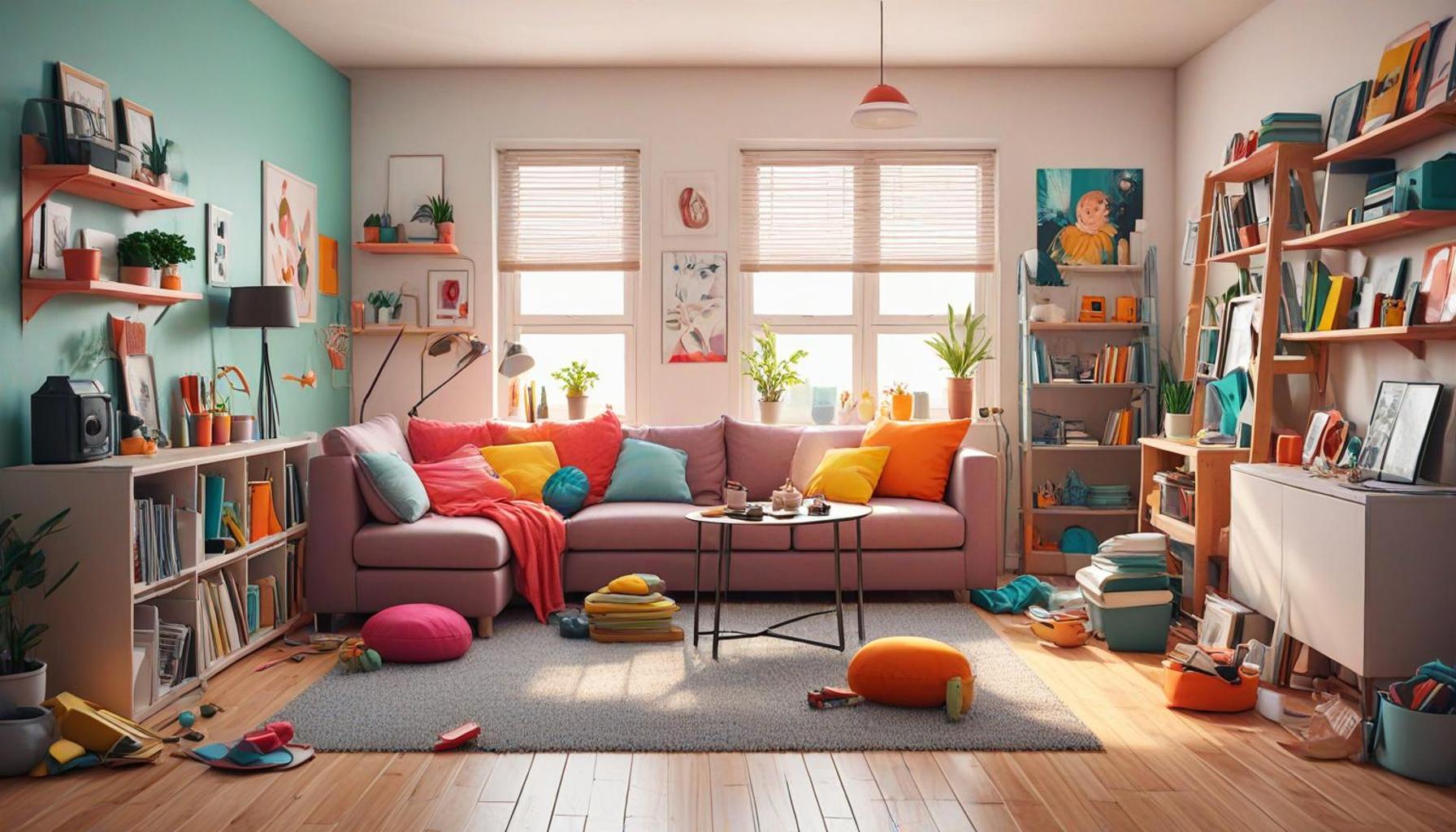Minimalism and Sustainability: How to Reduce Clutter and Waste at Home

Understanding Clutter in Modern Homes
The average American household accumulates an astonishing amount of clutter each year, with studies indicating that nearly 80% of individuals feel overwhelmed by the volume of possessions they own. This emotional weight often stems from our quest for the latest trends and conveniences fueled by relentless consumerism. With online shopping and fast fashion at an all-time high, it has become increasingly easy to lose track of what we truly need in our lives.
The Role of Minimalism in Sustainability
Adopting a minimalist lifestyle goes beyond simply decluttering; it invites you to rethink your relationship with your belongings and your environmental footprint. This shift can profoundly impact your life and the earth.
One of the most tangible benefits is decluttering. By prioritizing essentials, you can let go of unnecessary items that clog your living space. Consider the closet: many people hold onto clothing they haven’t worn in years. According to the Environmental Protection Agency (EPA), textile waste has increased significantly, with nearly 12 million tons of clothing ending up in landfills each year. By embracing minimalism, you help combat this issue by keeping only what you genuinely wear and enjoy.
- Reducing waste is another crucial aspect of minimalism. The less we own, the less we need to discard. By being mindful of the products we purchase, we can significantly minimize our contributions to landfills. For instance, opting for durable, reusable items—like water bottles or shopping bags—over single-use plastics demonstrates conscious living.
- Conscious shopping plays a vital role in a minimalist lifestyle. When consumers prioritize quality over quantity, they make informed decisions that foster sustainability. Choosing to invest in a few high-quality items rather than multiple cheaper products can lead to fewer purchases over time, ultimately reducing overall consumption.
Making Mindful Choices
Understanding minimalism is not merely about reducing the physical belongings you keep; it is also about making mindful choices that create a more fulfilling and promising lifestyle. Minimalism challenges the notion that happiness and fulfillment are tied to material possession. Instead, it embraces the idea that true satisfaction lies in experiences, connections, and personal growth.
As you navigate through this article, contemplate the impactful benefits of integrating minimalism and sustainability into your home. From decluttering your living space to decreasing waste, you’ll discover practical strategies that can transform your environment into a more harmonious and mindful oasis. By adopting these simple yet powerful changes, you will not only enhance your quality of life but also contribute positively to the planet’s health.

DISCOVER MORE: Click here for practical tips
Embracing Minimalism: The Foundation for Sustainable Living
To fully grasp the intersection of minimalism and sustainability, it’s essential to understand that minimalism is not merely a trend, but rather a tangible lifestyle choice that can lead to long-term environmental benefits. The minimalist movement encourages individuals to simplify their lives by eliminating excess and distraction, allowing for a clearer focus on what truly matters. This approach aids in reducing overall consumption and waste, leading to a more sustainable home.
One of the cornerstones of minimalism is the concept of intentional living. By evaluating each item in your home for its purpose and significance, you can create spaces that not only feel lighter but also align with your environmental values. It prompts a vital question: “Do I really need this?” If the answer is no, it paves the way for a healthier relationship with your possessions.
- Streamlined Spaces: Minimalism encourages uncluttered spaces, which can lead to improved mental clarity and focus. Research indicates that physical clutter can compromise our ability to concentrate and make decisions. By simplifying your surroundings, you create an environment conducive to creativity and productivity.
- Prioritizing Quality: Embracing minimalism often means investing in fewer, but higher-quality items. This practice not only reduces the demand for cheap, disposable products but also fosters the use of sustainable materials. For example, opting for furniture crafted from responsibly-sourced wood rather than particle board significantly reduces your consumption of non-renewable resources.
- Mindful Disposing: As you cull unused items from your home, consider donating or recycling wherever possible. Many communities have programs that accept gently used goods, ensuring they find new homes instead of suffocating landfills. There are countless second-hand shops across the United States eager to take in your pre-loved items, thereby contributing to a circular economy.
The surge of awareness around the environmental crisis has prompted many to explore minimalism not just as a lifestyle choice but as a practical solution to tackle the growing waste issue. According to the EPA, the United States generates approximately 292.4 million tons of trash each year, with less than 35% being recycled or composted. By adopting minimalist habits like reducing consumption, repurposing, and refusing unnecessary purchases, individuals can collectively make a considerable impact on this staggering statistic.
In conclusion, the connection between minimalism and sustainability reveals that decluttering your home is only one facet of a larger, more significant commitment. As we continue to explore the relationship between living simply and responsibly, consider how small changes in your everyday life can contribute to a larger vision of sustainability, thereby not only enhancing your personal well-being but also nurturing the environment in which we all live.
Understanding Minimalism in a Sustainable Context
In embracing the concept of minimalism, homeowners can significantly reduce both clutter and waste. Minimalism encourages the idea of owning less while focusing on the essentials that bring joy and functionality to everyday life. This not only results in a more orderly living space but also leads to less consumption and waste generation. By adopting minimalism, individuals learn to question their purchasing habits and resist the cycle of fast fashion and disposable goods.Minimalism and sustainability intertwine beautifully when individuals prioritize quality over quantity. Investing in durable and sustainable items ensures that fewer items are discarded prematurely, contributing to a healthier environment. For example, opting for high-quality kitchenware or multifunctional furniture reduces the need for additional, unnecessary purchases over time.
Practical Steps to Reduce Clutter and Waste
Implementing practical strategies at home can dramatically streamline one’s living space while supporting sustainable practices. Here are some actionable steps to consider:1. Decluttering Regularly: Start with a plan to declutter different areas of the home systematically. Identify items that no longer serve a purpose and set aside time each month to clear them out. Consider donating, recycling, or selling items whenever possible.2. Mindful Purchasing: Before making a purchase, ask yourself if an item is truly needed. This simple practice can help curb impulsive purchases that often lead to clutter and waste. Utilizing a shopping list can also promote mindful buying habits.3. Sustainable Alternatives: When replacing items, source sustainable alternatives. For instance, instead of buying single-use plastics, consider investing in reusable containers and shopping bags made from eco-friendly materials. This shift not only enhances sustainability but also contributes to reducing household waste.4. Digital Clutter Management: Don’t forget to declutter your digital spaces. Organize files, unsubscribe from unwanted emails, and delete unused apps. A clean digital workspace is just as important as a tidy physical space and can improve overall productivity.By integrating these practical steps into your daily routine, you’ll foster an atmosphere that reflects the dual ideals of minimalism and sustainability, significantly benefiting both your living space and the planet.
| Advantages | Impact on Home |
|---|---|
| Enhanced Space Utilization | Maximizes efficiency and comfort while living. |
| Reduction of Waste | Minimizes environmental footprint and promotes sustainability. |
Engaging in a journey toward minimalism and sustainability not only enriches your personal living environment but fosters a broader movement toward environmental responsibility. Adopting these practices heralds significant changes both at home and in the greater community, inviting others to join in the endeavor.
DISCOVER MORE: Click here to uncover practical tips
Practical Tips to Cultivate Minimalism and Sustainability at Home
As you embark on your journey towards a more minimalist and sustainable lifestyle, it’s important to adopt practical strategies that integrate these philosophies into your daily routine. By implementing small changes, you can not only declutter your living space but also contribute to environmental preservation.
- The 30-Day Minimalism Challenge: A popular initiative that encourages individuals to reduce the number of items they own is the 30-Day Minimalism Challenge. This involves removing one item on Day 1, two items on Day 2, and so on, until you reach 30 items on Day 30. Through this structured approach, you can gradually assess what you truly value and make informed decisions about disposal, recycling, or donation.
- Digital Decluttering: Minimalism is not limited to physical possessions. In our digital age, clutter can also manifest in our virtual spaces. Unsubscribe from unnecessary emails, delete unused apps, and organize your digital files. This not only frees up mental space but also reduces energy consumption, as less data storage requires less electricity.
- Adopt the One-In-One-Out Rule: To maintain a clutter-free home, consider implementing the one-in-one-out rule: for every new item you bring into your home, commit to removing an existing one. This practice helps to prevent unnecessary accumulation, minimizing waste and encouraging thoughtful purchases.
- Mindful Shopping Practices: Embracing mindfulness in your shopping habits can significantly impact your ecological footprint. Before making a purchase, ask yourself whether the item is something you genuinely need, if it serves multiple purposes, and how it aligns with your values of sustainability. Consider the longevity and repairability of products, as investing in durable goods can reduce waste.
- Utilize Local Resources: Take advantage of local resources to support a minimalist and sustainable lifestyle. Many communities offer swap events, where residents can exchange items they no longer need. Engaging in such activities fosters community spirit while ensuring that items are reused efficiently.
Data reveals that Americans buy an average of 60 items of clothing per year, leading to alarming levels of textile waste. By choosing to buy second-hand or upcycle existing garments, you contribute not only to sustainability but also to reducing the demand for fast fashion, which has a notorious environmental impact. Thrift shops and consignment stores can be great sources for affordable, quality clothing that reduces waste in landfills.
Furthermore, involving your family in minimalism can create a collective culture of sustainability at home. Teach children the importance of valuing experiences and relationships over material possessions. Engaging them in activities such as nature walks or community cleanups can nurture an appreciation for the planet while instilling minimalist values from a young age.
Monitor your consumption habits through apps designed to track environmental impact. For example, applications that calculate your carbon footprint can uncover areas for improvement in your lifestyle choices, highlighting how even small actions, such as reducing meat consumption or choosing public transport, can claw back on emissions.
Incorporating these practical tips into your life can streamline your journey toward minimalism and sustainability. By adopting intentional living practices, you slow down the cycle of consumption and waste, promoting an enriching lifestyle that benefits both you and the environment.
DON’T MISS OUT: Click here to enhance your workspace
Conclusion: Embracing a Lifestyle of Minimalism and Sustainability
In conclusion, the intersection of minimalism and sustainability presents a profound opportunity to reshape our homes, habits, and ultimately, our planet. Each small step you take towards decluttering your space and curbing waste contributes not only to personal well-being but also to a healthier environment. By adopting practices like the 30-Day Minimalism Challenge, you can re-evaluate possessions that once seemed essential, allowing you to prioritize what truly adds value to your life.
Importantly, the integration of mindful shopping habits in your consumer approach is crucial. As more people awaken to the implications of fast fashion and disposable culture, choosing sustainable alternatives and second-hand products becomes not just a personal choice but a societal necessity. With Americans discarding an astonishing amount of 300 million tons of waste annually, every decision counts. The one-in-one-out rule can be your beacon to prevent further clutter while ingraining a sense of intentionality in your purchases.
Moreover, fostering community connections through local swap events and promoting awareness within your family can build a foundation of environmental stewardship. As we embrace minimalism in both tangible and digital realms, let us recognize that our consumption patterns have the power to influence change and strengthen bonds with our community and nature. With a conscious commitment to these ideologies, we not only create peaceful, organized homes, but also pave the way for a sustainable future.
Together, through informed choices and deliberate actions, we can cultivate a lifestyle rooted in minimalism and sustainability, ultimately leading to a more balanced coexistence with our environment.



